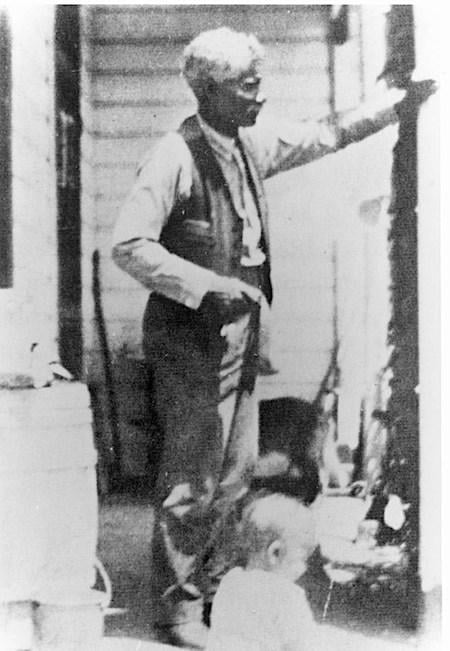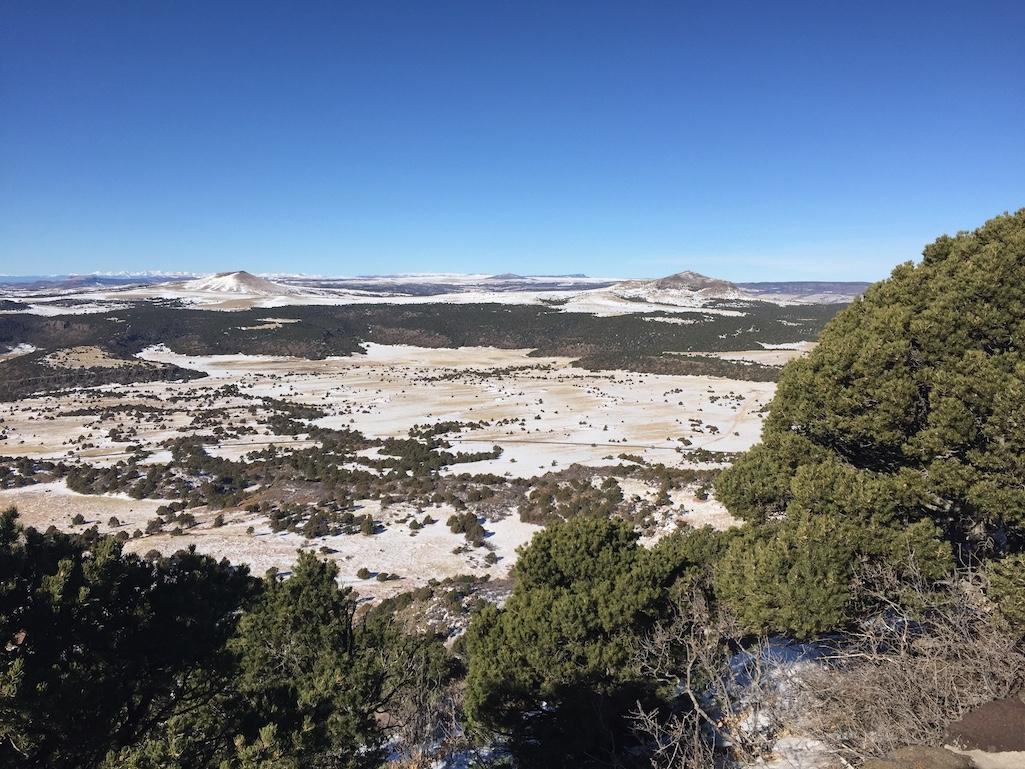
Capulin Volcano National Monument/NPS
It’s winter in cattle country, in northeastern New Mexico. Dark brown Herefords and a few black Angus graze the dry grasses found between scattered snowdrifts, waiting for a familiar truck and the ranch hand who will unload hay. Horses, too, linger beyond barbwire fences, their long manes and tails swaying in the gusts of a chilly wind, the sun bright but cold. Behind the slowly moving herds, greasewood and rabbitbrush speckle low volcanic hills, the only shelter for miles.
A half-hour’s drive east of Raton, Capulin Volcano comes into view. Capulin Volcano National Monument protects this near-perfect cinder cone that last erupted 60,000 years ago. Abruptly rising 1,000 feet from the plains to an altitude of 8,182 feet, this landmark caught the eye and captured the imagination of legendary cowboy George McJunkin.
McJunkin was born a slave on John Sanders McJunkin’s ranch in central Texas in 1851. From an early age, George wanted to be a cowboy. He reportedly loved their stories of adventure – and freedom. When the Civil War broke out in 1861, many local men joined the fighting, leaving ranch hands in short supply. His father, called “Shoe Boy,” was a blacksmith, not a cowboy; allowed to hire out his services to other ranches, he had saved enough money to buy his freedom, and was saving to free his son, too. With that same resourcefulness, George sought out Mexican vaqueros, some working at nearby ranches, others passing by on cattle drives to Abilene and Dodge City, to teach him all they knew about horse wrangling.
When the war ended in 1865, George was emancipated. Just a 14-year-old boy, however, he stayed on at the ranch another three years, working with livestock and helping his father with blacksmithing. By 17, young McJunkin was ready to follow his dream of becoming a true cowboy. He left home alone and found work outside Comanche, Texas, riding on cattle drives. Next, he trained horses for Gideon Roberds, a former slave owner from Georgia, to sell along the Santa Fe Trail. McJunkin helped Roberds set up his permanent spread east of Trinidad, Colorado. The story goes that McJunkin taught Roberds’ boys, Emmett and Coke, how to break horses, and in exchange, they taught him to read.

Capulin Volcano National Monument is near where rancher George McJunkin discovered the “Folsom points,” stone projectile points used by prehistoric bison hunters. This incredible find revealed that humans lived in North America around 9000 BCE, almost 7,000 years earlier than previously known. Learn more about this park in the book Capulin Volcano National Monument or bring home an official park product from Western National Parks Association/NPS archives
By all accounts, McJunkin was hungry to learn: how to wrangle horses, to read, to speak Spanish, to play the violin, to find constellations in the night sky. Fascinated by natural sciences, he collected petrified wood, minerals, and bones to study.
As his reputation for hard work and excellent horsemanship grew, McJunkin was hired by Dr. Thomas Owen, a former Confederate Army officer and the first mayor of Trinidad, to work his Hereford Park ranch on the Dry Cimarron River.
McJunkin had fallen in love with the Dry Cimarron area when he passed through on cattle and horse drives. According to the Folsom Museum, McJunkin climbed Capulin Volcano, taking in commanding views of broad grasslands from its summit, with the snowy peaks of the Sangre de Cristo Mountains to the west. He declared the area “my promised land,” a Biblical reference to Moses leading the Israelites from captivity to a land of their own, and freedom.
Stories abound of his courage and character. How he intervened to save a cavalry lieutenant outnumbered by bandits seeking the military payroll, and how the grateful army officer gave him a telescope in return, which McJunkin carried on his saddle. How he notified the sheriff when he found members of the Ketchum Gang, who had just robbed a train, camped nearby; a search of the campsite yielded a torn note listing their next destination, where they were swiftly apprehended. How, during a 10-day blizzard, he led 20 cowboys and what was left of their herds to safety. How, when Dr. Owen died suddenly, McJunkin helped Owen’s widow and young sons, Ben and Tom, work their ranch until the boys were old enough to take over.
At the nearby Crowfoot Ranch, McJunkin was made ranch foreman, a rare position for a black man in the 1890s. It was widely acknowledged that he was the best horseman and cowboy in the region. Black, white, and Hispanic cowboys all worked together under his direction.
McJunkin built himself a cabin on the Crowfoot Ranch, settling down at last. He hung shelves to display his collection of artifacts. With his telescope and a transom, he acted as local surveyor, establishing property lines and putting up fences. He bought his own herd of cattle. He played fiddle and guitar at local dances.
In August of 1908, a heavy thunderstorm dropped 14” of rain on the headlands of the Dry Cimarron, and a flash flood swept through the area, killing 17 people in the nearby village of Folsom. As McJunkin rode out to assess the damage, he saw that floodwater had substantially eroded Wild Horse Arroyo. Sticking out of a newly-exposed layer of rock ten feet down, he spied what looked like bison bones – but they were much bigger. And buried at that depth, he knew they were much older, too.
It wasn’t until 1926, four years after McJunkin’s death, that museum archaeologists would verify McJunkin’s find: skeletons of bison antiquus, from the Late Pleistocene. And, lodged in rib bones still buried in the arroyo, they found stone points, weapons of people who would come to be known as Folsom Man, proving that humans had lived in North America thousands of years earlier than previously thought. It was arguably one of the most important archaeological discoveries of the twentieth century.
In 2019, George McJunkin was inducted into the Hall of Great Westerners at the National Cowboy and Western Heritage Museum. Matt Doherty, the great-great-great-grandson of Dr. Owen, accepted the award on McJunkin’s behalf.

Neighboring cinder cones can be seen from the rim trail on Capulin Volcano. Capulin Volcano is part of the Raton-Clayton Volcanic Field, which covers nearly 8,000 square miles from Colorado to New Mexico. The volcano erupted about 60,000 years ago, making it one of the most recent eruptions in this field. Learn more about this park in the book Capulin Volcano National Monument or bring home an official park product from Western National Parks Association/Barbara Jensen photo
You can take in some of the same views McJunkin did when you visit the national monument. An accessible nature trail outside the visitor center winds through an educational exhibit featuring the plants, animals, and geology of Capulin Volcano National Monument. A precipitous, narrow road offers long views across four states as it spirals up and around Capulin Volcano’s steep flanks to the summit. Hiking trails let you explore the extinct volcano’s vents and lava flow formations up close, and allow you to walk down into the crater’s bowl.
The 793-acre site is still a landmark for those passing through the area: pronghorn, mule deer, black bear, and migrating elk all stop here, seeking food and shelter in the pinyon/juniper woodland. At night, you can pull out your telescope or binoculars to gaze at the stars for hours in this Gold Tier International Dark Sky Park; when scheduling resumes, attend a guided moonlight hike or the Dark Sky Festival.
More than ever, Capulin Volcano National Monument captures the imaginations of those who travel off the beaten path. With less than 100,000 visitors each year, the monument offers a relatively pristine experience – clean air, clear skies, and an abiding, deep quiet. High above the wide prairies, you can walk a one-mile rim trail around the top of Capulin Volcano, looking out at a cowboy’s promised land where cattle, horses, and bison still roam, reflecting on the curiosity, grit, and resilience of George McJunkin.
This story was made possible in part through the support of the Western National Parks Association.
Read More: Black Cowboys of the Old West: True, Sensational, and Little-Known Stories from History by Tricia Martineau Wagner, available at the Capulin Volcano Visitor Center. Also, learn more about the volcanic Southwest from Jim Stratton's article, Discovering Lava In The Southwest.
Barbara Jensen is a writer and artist who likes to go off-grid, whether it's backpacking through national parks, trekking up the Continental Divide Trail, or following the Camino Norte across Spain. For over 20 years, social work has paid the bills, allowing them to meet and talk with people living homeless in the streets of America. You can find more of Barbara's work on Out There podcast and www.wanderinglightning.com
Follow @wanderlightning wanderinglightning@gmail.com

 Support Essential Coverage of Essential Places
Support Essential Coverage of Essential Places




Comments
Great! Thank you for sharing this story. When I was in the park, I saw only one mention of McJunkin.
We've stopped there several times. Once we had my mom, in a wheelchair. My long-suffering husband wheeled her down all the way to the bottom of the bowl and back up. (He's a keeper!!) Anybody who thinks this is just a hill with a hole at the top is missing a real neat place!
Using part of this for my New Mexico History class! Thanks!
This is Geoff Goins, I am the Chief of Interpretation at Capulin. We are remedying that. We now have a feature in the museum about George, and a new film being produced about him that will be on our website. We are also working on a refit of our museum and George will be featured much more prominently.